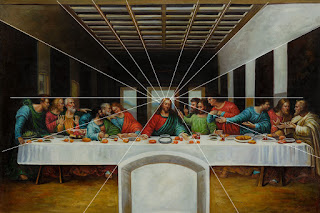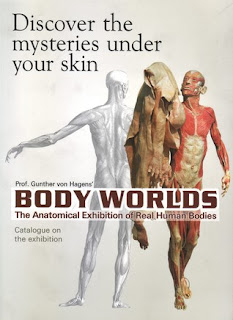Week 2: Math + Art (Visual and Musical)
In this week’s lesson, we learned
about how mathematics influenced art and science in history. An example of a
paradigm shift in the history of art was the introduction of linear perspective.
Based on the mathematics and science of physical optics, linear perspective
heavily influenced artists during the Renaissance period. Techniques such as
the vanishing point helped paintings appear geometrically correct, effectively reproducing
reality in the eyes of art spectators. Leonardo da Vinci’s “The Last Supper”
perfectly portrays the use of one-point perspective in this famous art piece.
(Leonardo da Vinci's "The Last Supper", with lines to emphasize linear perspective)
In history,
mathematics also influenced the construction of other forms of art, such as
architecture and music. For example, the Great Pyramids of Giza and the
contemporary Modulor system are based on the golden ratio, developed by Greek
mathematicians. Lastly, this week’s readings provided insight into the use of
mathematics in musical art. Art and mathematics (along with science) are often described
in juxtaposition, but the incorporation of both can result in both expressive
and transformative modern works of art.
(The use of the golden ratio in the construction of the Great Pyramids of Giza)
Personally,
I have experienced the power of understanding the mathematics behind musical
art. Briefly mentioned in the previous paragraph, music theory also involves
the language of mathematics. The two short YouTube videos below explain how
math and music are combined. The one on the left explains how many different
types of musical genres can be broken down into basic underlying rhythms.
Artistic expression depends on how the rhythms are layered upon each other.
The video on the right is a detailed analysis of Beethoven’s “Moonlight Sonata.” As
explained in this week’s reading, musical notes can be mathematically described
as sine waves of different frequencies. In his time, Beethoven was a musical
genius who was unaware of the mathematics in making music sound good. His “Moonlight
Sonata” consists of triads, which can either form consonance or dissonance
depending on the common zero intercepts of the three notes’ frequencies. After
this lesson, and from my experiences playing in high school orchestras, I have
grown to appreciate the intersection of mathematics and art to create beautiful
music.
(Short YouTube videos explaining how musical art and math intertwine)
References:
Burk, Phil, Larry Polansky, Douglas Repetto, Mary
Roberts, and Dan Rockmore. "Section 1.3: Frequency, Pitch, and
Intervals." Music and Computers: A Theoretical Approach. N.p., n.d. Web. 16 Apr. 2017.
TED-Ed. Music
and math: The genius of Beethoven – Natalya St. Clair. Online video clip.
YouTube. YouTube, 9 Sept. 2014. Web. 16 Apr. 2017.
TED-Ed. A
different way to visualize rhythm – John Varney. Online video clip. YouTube.
YouTube, 20 Oct. 2014. Web. 16 Apr. 2017.
Vesna,
Victoria. Mathematics-pt1-ZeroPerspectiveGoldenMean.mov.
Online video clip. YouTube. YouTube, 9 Apr. 2012. Web. 16 Apr. 2017.
Image Sources:
Britton, Jill. ""Golden Section in Art and
Architecture"." Jill Britton's HOME. Camosun College Department of Mathematics, n.d. Web. 16
Apr. 2017.
"The Last Supper: Linear and Arerial
Perspective." Nia's Specialist Contextual Investigation. Wordpress.com, 18 Mar. 2014. Web. 16 Apr. 2017.




Comments
Post a Comment